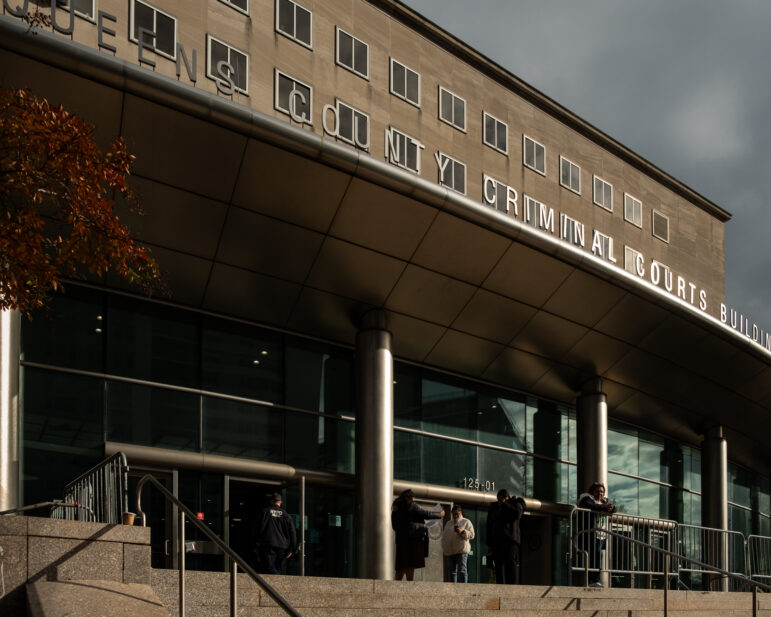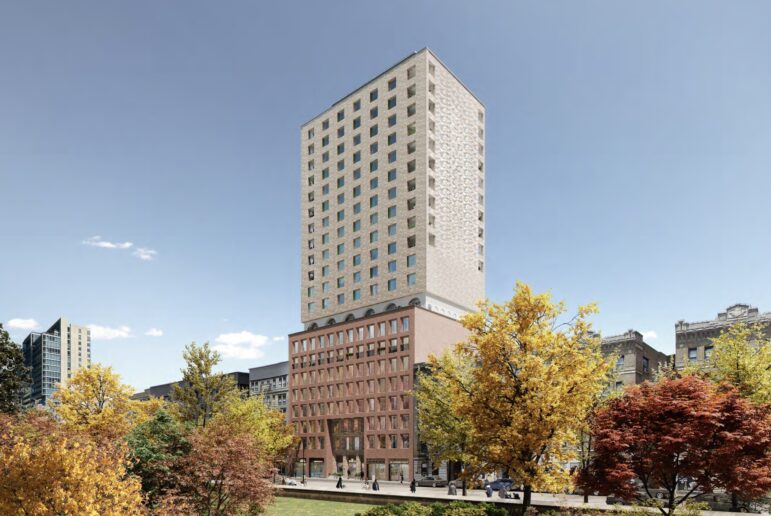Dr. Clarice Bailey was sent to New York City by the Ash Institute for Democratic Governance and Innovation at Harvard’s Kennedy School of Government to find out what it’s like inside the city’s program for juvenile justice reform. The Institute had its eye on the Department of Probation initiative called “Project Zero,” which seeks alternative kinds of rehabilitation to locking up young offenders in juvenile jail. Bailey spoke with probation officers, staff at the family courts of Manhattan and Brooklyn, and counselors who work one-on-one with families in the system. Then she met the youths.
She recalled what the kids said about the adult staffers assigned to help them: “They’re like family. I’m close to them. They helped me when I got kicked out of my grandma’s house. They made sure I was all right.”
Bailey, who has a doctorate in public administration and policy and has worked closely with youth involved in criminal activity and the justice system, came away impressed. Last month, the Ash Institute announced Project Zero had been selected from a pool of about 1,000 applicants as a finalist for the Annie E. Casey Innovations Award in Children and Family System Reform.
Hope – and statistics
Probation Commissioner Martin Horn started the program in 2003, with “zero” standing for the goal of sending no kids to juvenile correctional facilities outside the city. Instead, they would return home to live with their families, attend school as usual, and participate in intensive therapy sessions aimed at helping them get on the right path from inside their own neighborhoods.
In the year before Project Zero began, 1,300 to 1,500 New York City youths were sent to juvenile facilities, according to Department of Probation (DOP) statistics. In 2004, the Department sent 1,257 juveniles to state correctional facilities, and by 2007, 795 juveniles were admitted. DOP data also show that from 2002 to 2007, the number of city youth incarcerated as a result of their Family Court judgment decreased by 27 percent. The DOP reports that this decline was caused by the Project Zero initiative.
“The administration of juvenile justice in our country is marked by an absence of coherent leadership and is essentially unmanaged. Project Zero represents our resolve to take advantage of that vacuum and change the paradigm in New York from the bottom up,” Horn told the award’s national selection committee at Harvard in June.
Horn credited Mayor Bloomberg with making an unprecedented commitment to reforming the system. Attempts had been made in the past – particularly during the Koch and Giuliani administrations – but never before at this scale, he said.
In addition, the DOP took advantage of new technologies that made better data analysis possible. That’s part of what makes Project Zero innovative, said Bailey, a former senior associate with the Annie E. Casey Foundation now working as an independent social services contractor in Philadelphia. “It’s not this big mystery or scary thing, but rather it’s a tool that is used day in and day out to help make decisions about where kids get placed, how kids get placed,” she said. The program consistently evaluates its own progress and makes adjustments accordingly, based on data. “It keeps people from making really willy-nilly decisions.”
Some of the data is impressive. For young people who participated in Project Zero’s community-based intensive care program, Esperanza, it shows a big drop in the juvenile re-arrest rate after nine months – from 50 percent in 1999 to 16 percent in 2007.
The financial statistics are also attention-getting, because it costs more to send kids to correctional facilities than it does to keep them at home. Before Project Zero, the city paid up to $80 million each year to lock up juveniles in prison. Now, the mayor’s office projects the program will save the city $43 million over the next four years.
While incarceration costs between $120,000 and $200,000 per year, per youth—according to the most recent data from the state Office of Children and Family Services—the DOP says Esperanza costs $15,000 per year, per youth.
Though Horn got the initiative off the ground, Esperanza Director Jenny Kronenfeld is running it day to day. For her, the reward extends beyond the city’s monetary savings – she has seen young people go from juvenile court to college campus. That’s fitting, since “esperanza” is the Spanish word for hope.
Project Zero “pushed everybody to think really broadly: Is there anything else we can do in the community?” Kronenfeld said, adding that the program also espouses a more realistic – meaning patient – perspective on youth development. Leaders accept that change happens in small steps: If a teenager never goes to school, then starts to go three days a week, that’s something. “Change doesn’t happen over night,” she said. “It takes time.”
In an interview, Horn offered a hypothetical typical Esperanza case under the umbrella of Project Zero: A teenager is charged with stealing a classmate’s iPod after some history of truancy and the beginnings of gang involvement. Although he is a high-risk candidate for further crime, his family is intact and he is motivated to turn his life around. When he is taken on by Esperanza, he is assigned a case manager who will be accessible to him seven days a week, and who’s only handling up to five other cases at any given time.
That kind of relationship creates an atmosphere for discussing the larger picture. “They have opened discussions about oppression,” says Bailey. Most of the youth who enter what those in the field often call the “crib to prison pipeline” are black or Latino, she said. Esperanza teaches how to “operate in, successfully negotiate our society, which is built on oppression.”
She added that staffers “help them get their context from their story as a young person of color in this system – in not just the juvenile system, but our social system, that doesn’t have their best interest at heart.”
City Councilwoman Sara Gonzalez, who chairs City Council’s Juvenile Justice Committee, supports the Project Zero philosophy. Her legislative director Miguel Hernandez said, “These are kids we’re talking about. When someone makes a mistake, we want to make sure we’re not setting them up for failure” – which is more likely to result after a young person has spent time in prison.
Leaving beds empty
Yet as Project Zero’s success is lauded by Harvard, the program struggles for a warmer reception in Albany. When the Ash Institute award committee asked about tension between the city and state in funding alternatives to juvenile incarceration, Commissioner Horn chuckled. He and Deputy Commissioner Patricia Brennan, who stood beside him, asked, “How much time you got?”
According to a city newsletter from last August, “Probation Today,” Brennan has said the state does too little to encourage the development of alternatives to incarceration for juveniles.” Horn describes his department’s relationship to the state as a “creative tension.” When money is spent running underused state prisons, it can’t be invested in alternative juvenile programs.
Since last year, the state’s Office of Children & Family Services announced the closing of six juvenile correctional facilities – because of Project Zero and other programs like it. “We were paying for a lot of empty beds,” OCFS spokesman Edward Borges said. But when the plan came before the state legislature, it was chiseled down to closing three prisons, merging two programs in the Adirondacks into one, and shutting down one wing of the Lansing juvenile facility.
The state Senate ensured that Great Valley, the correctional facility in the western corner of the state, would stay open – even though it was half empty, Borges said. He explained, “It makes no sense for us to ship kids from New York City all the way up there. We were disappointed.” Pyramid, a prison in the Bronx, also remains despite what Borges described as inadequate facilities.
“That’s where I guess you get into the politics,” said State Assemblyman William Scarborough, a Queens Democrat. As chairman of the Assembly’s Committee on Children and Families, he supported the plan to close all six prisons, but he was unable to push it through budget negotiations.
State Senator Carl Kruger, chairman of the Senate’s Social Services, Children and Families Committee, said “it just made sense” to keep Pyramid open. The Brooklyn Democrat argued that it serves as more of a residential than correctional facility for juveniles – playing an essential role, within the city.
But in upstate communities, the justice system is “an economic engine,” Scarborough explained, employing generations of families. He and his colleagues in the Legislature received letters from unions that represent prison employees. He recalled their message, “You can’t close our facilities – they contribute a million dollars to our economy.”
Kruger contends that Project Zero is asking too much of the state when it requests that the money saved by running fewer juvenile facilities be invested into city alternatives-to-detention programs. “The city would like the state to pay for everything,” he said. “They would like to hijack as much money from us as they can.”
DOP spokesperson Jack Ryan said, “We would like to receive our fair share.” When juvenile prisons close, the DOP believes the savings should be reinvested in developing incarceration alternatives where need is greatest—in New York City.
Though Scarborough is counting on OCFS to renew its push for more prison closings and remains optimistic about the outcome in the next fiscal year’s budget, he doesn’t foresee legislation emerging to support juvenile incarceration alternatives before then. “You can put forward legislation, but you’re going to run into the same problem,” he said.
It may take awhile, but Commissioner Horn believes the state will have to follow Project Zero’s lead eventually, when “the reality becomes too stark for even the New York State Legislature to ignore, and ultimately the money will materialize.”
In the meantime, Harvard will announce its winner in September – the recipient of $100,000. Should DOP win, Ryan says the department doesn’t yet know how it would use the prize.







